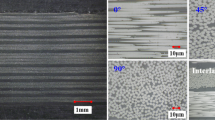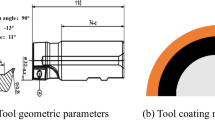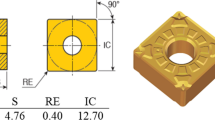Abstract
Carbon fiber-reinforced plastics (CFRP) are widely used in the aerospace and automobile industries because of their ultralight weight, high strength, excellent corrosion resistance, and anti-fatigue properties. However, the machining of CFRP is still challenging due to its super hardness and sensitivity to heat. Cryogenic milling is a kind of sustainable manufacturing process which is considered to have great potential for processing CFRP. This work is devoted to analyzing the tool wear and surface quality under dry and cryogenic conditions based on liquid nitrogen (LN2) and also provides a reference for selecting parameters of CFRP processing in industries. A series of tests were conducted under various cutting speeds, feed per tooth, and LN2 jet temperatures. In order to reveal the changing laws of tool wear and surface quality, flank wear bandwidth (VB), surface roughness (Sa) and burr factor (Fb) were carried out. The experimental findings have shown that tool wear is suppressed at high cutting speed and feed rate. In addition, surface quality is significantly improved at an appropriate temperature, and burr damage was also effectively suppressed with the temperature dropping, while tool wear is severer at − 196 ℃ than in dry conditions.




















Similar content being viewed by others
Availability of data and materials
All data generated or analyzed during this study are included in this published manuscript.
References
Geier N, Davim JP, Szalay T (2019) Advanced cutting tools and technologies for drilling carbon fibre reinforced polymer (CFRP) composites: a review. Compos Part A-Appls 125:105552. https://doi.org/10.1016/j.compositesa.2019.105552
Karataş MA, Gökkaya H (2018) A review on machinability of carbon fiber reinforced polymer (CFRP) and glass fiber reinforced polymer (GFRP) composite materials. Def Technol 14:318–326. https://doi.org/10.1016/j.dt.2018.02.001
Danish M, Gupta MK, Rubaiee S, Ahmed A, Mahfouz A, Jamil M (2019) Machinability investigations on CFRP composites: a comparison between sustainable cooling conditions. Int J Adv Manuf Tech 114:3201–3216. https://doi.org/10.1007/s00170-021-07073-8
Hosokawa A, Hirose N, Ueda T, Furumoto T (2014) High-quality machining of CFRP with high helix end mill. CIRP Ann-Manuf Techn 63:89–92. https://doi.org/10.1016/j.cirp.2014.03.084
Liu L, Lian B, Zhou C, Duan K, Zhu X, Xia P (2021) Research on drilling CFRP laminate with a thin woven glass fiber surface layer using plane rake–faced twist drill. Int J Adv Manuf Tech 117:1781–1796. https://doi.org/10.1007/s00170-021-07796-8
Wang C, Liu G, An Q, Chen M (2017) Occurrence and formation mechanism of surface cavity defects during orthogonal milling of CFRP laminates. Compos Part B-Eng 109:10–22. https://doi.org/10.1016/j.compositesb.2016.10.015
Li HN, Wang JP, Wu CQ, Zhao YJ, Xu J, Liu X, Zhu WQ (2020) Damage behaviors of unidirectional CFRP in orthogonal cutting: a comparison between single- and multiple-pass strategies. Compos Part B-Eng 185:107774. https://doi.org/10.1016/j.compositesb.2020.107774
Ozkan D, Panjan P, Gok MS, Karaoglanli AC (2020) Experimental study on tool wear and delamination in milling CFRPs with TiAlN- and TiN-coated tools. Coatings 10:623. https://doi.org/10.3390/coatings10070623
Turner J, Scaife RJ, El-Dessouky HM (2015) Effect of machining coolant on integrity of CFRP composites. Adv Manuf-Polym Comp 1:54–60. https://doi.org/10.1179/2055035914Y.0000000008
Wang H, Zhang X, Duan Y (2018) Effects of drilling area temperature on drilling of carbon fiber reinforced polymer composites due to temperature-dependent properties. Int J Adv Manuf Tech 96:2943–2951. https://doi.org/10.1007/s00170-018-1810-7
Jia Z, Fu R, Wang F, Qian B, He C (2018) Temperature effects in end milling carbon fiber reinforced polymer composites. Polym Composite 39:437–447. https://doi.org/10.1002/pc.23954
Zou F, Zhong B, Zhang H, An Q, Chen M (2021) Machinability and surface quality during milling CFRP laminates under dry and supercritical CO2-based cryogenic conditions. Int J PR Eng Man-GT 9:765–781
Elgnemi T, Songmene V, Kouam J, Jun MBG, Samuel AM (2021) Experimental investigation on dry routing of CFRP composite: temperature, forces, tool wear, and fine dust emission. Materials 14:5697. https://doi.org/10.3390/ma14195697
Koklu U, Morkavuk S (2019) Cryogenic drilling of carbon fiber-reinforced composite (CFRP). Surf Rev Lett 26:9. https://doi.org/10.1142/S0218625X19500604
Xia T, Kaynak Y, Arvin C, Jawahir I (2016) Cryogenic cooling-induced process performance and surface integrity in drilling CFRP composite material. Int Adv Manuf Tchnol 82:605–616. https://doi.org/10.1007/s00170-015-7284-y
Nor Khairusshima MK, Sharifah ISS (2017) Study on tool wear during milling CFRP under dry and chilled air machining. Procedia Engineering 184:506–517. https://doi.org/10.1016/j.proeng.2017.04.121
Kumar D, Gururaja S (2020) Machining damage and surface integrity evaluation during milling of UD-CFRP laminates: dry vs. cryogenic. Compos Struct 247:112504. https://doi.org/10.1016/j.compstruct.2020.112504
Zou F, Dang J, Wang X, Zhang H, Sun X, An Q, Chen M (2021) Performance and mechanism evaluation during milling of CFRP laminates under cryogenic-based conditions. Compos Struct 277:114578. https://doi.org/10.1016/j.compstruct.2021.114578
Cococcetta N, Jahan MP, Schoop J, Ma J, Pearl D, Hassan M (2021) Post-processing of 3D printed thermoplastic CFRP composites using cryogenic machining. J Manuf Process 68:332–346. https://doi.org/10.1016/j.jmapro.2021.05.054
Ohashi K, Maeno H, Fujihara R, Fujihara R, Kubota S, Yoshikawa M, Tsukamoto S (2013) Influence of grinding atmosphere on grinding characteristics of CFRP (effect of soluble coolant or liquid nitrogen supply). Trans Japan Soc Mech Engi P C 5068–5078
Morkavuk S, Köklü U, Bağcı M, Gemi L (2018) Cryogenic machining of carbon fiber reinforced plastic (CFRP) composites and the effects of cryogenic treatment on tensile properties: a comparative study. Compos Part B-Eng 147:1–11. https://doi.org/10.1016/j.compositesb.2018.04.024
Karpat Y, Bahtiyar O, Deger B (2012) Milling force modelling of multidirectional carbon fiber reinforced polymer laminates. Procedia CIRP 1:460–465. https://doi.org/10.1016/j.procir.2012.04.082
Xu Q (2018) A design of cooling system and cutting experiments for the cryogenic machining of difficult-to-cut materials. Dissertation, Nanjing University of Aeronautics and Astronautics
Chen D, Mastumoto R, Arakawa K, Yoon S (2014) Energy absorption property of CFRP under impact loadings. Appl Mech Mater 566:219–224. https://doi.org/10.4028/www.scientific.net/AMM.566.219
Shindo Y, Takeda T, Narita F, Saito WS, Sanada K (2009) Delamination growth mechanisms in woven glass fiber reinforced polymer composites under mode II fatigue loading at cryogenic temperatures. Compos Sci Technol 69:1904–1911. https://doi.org/10.1016/j.compscitech.2009.04.010
Nishijima S, Honda Y, Okada T (1995) Application of the positron annihilation method for evaluation of organic materials for cryogenic use. Cryogenics 35:779–781. https://doi.org/10.1016/0011-2275(95)90913-Z
Karpat Y, Bahtiyar O, Değer B (2012) Mechanistic force modeling for milling of unidirectional carbon fiber reinforced polymer laminates. Int J Mach Tool Manu 56:79–93. https://doi.org/10.1016/j.ijmachtools.2012.01.001
Kim M, Lee M, Cho G, Lee SK (2020) Effect of the fiber orientation and the radial depth of cut on the flank wear in end milling of CFRP. Int J Pr Eng Man-Gt 21:1187–1199. https://doi.org/10.1007/s12541-020-00340-w
Han SC, Chen Y, Xu JH, Zhou JW (2013) Experimental study of tool wear in milling multidirectional CFRP laminates. Mater Sci Forum 770:276–280. https://doi.org/10.4028/www.scientific.net/MSF.770.276
Wang CY, Wen L, Wang CD, Zhang HZ, An QL, Chen M (2016) Influence of fiber orientation on machined surface quality in milling of unidirectional CFRP laminates. Advanced Materials Research 1136:137–142. https://doi.org/10.4028/www.scientific.net/AMR.1136.137
An Q, Cai C, Cai X, Chen M (2019) Experimental investigation on the cutting mechanism and surface generation in orthogonal cutting of UD-CFRP laminates. Compos Struct 230:111441. https://doi.org/10.1016/j.compstruct.2019.111441
Hadda M, Zitoune R, Eyma F, Castanie B (2014) Study of the surface defects and dust generated during trimming of CFRP: influence of tool geometry, machining parameters and cutting speed range. Compos Part A-Appls 66:142–154. https://doi.org/10.1016/j.compositesa.2014.07.005
Ozkan D, Gok MS, Gokkaya H, Karaoglanli AC (2019) The effect of cutting parameters on tool wear during the milling of carbon fiber reinforced polymer (CFRP) composites. Mater Sci-Medzg 25:1. https://doi.org/10.5755/j01.ms.25.1.19177
Gemi L, Morkavuk S, Koklu U, Yazman S (2020) The effects of stacking sequence on drilling machinability of filament wound hybrid composite pipes: part-2 damage analysis and surface quality. Compos Struct 235:111737. https://doi.org/10.1016/j.compstruct.2019.111737
Liu JD, Li YS, Yan GH, Huang LK, Yang XF, Yu DM (2015) Experimental study on surface quality in milling carbon fiber reinforced plastics. Key Eng Mater 667:62–67. https://doi.org/10.4028/www.scientific.net/KEM.667.62
Yazman S (2021) The effects of back-up on drilling machinability of filament wound GFRP composites pipes: mechanical characterization and drilling tests. J Manuf Process 68:1535–1552. https://doi.org/10.1016/j.jmapro.2021.06.054
Gemi L, Morkavuk S, Koklu U, Gemi D (2019) An experimental study on the effects of various drill types on drilling performance of GFRP composite pipes and damage formation. Compos Part B-Eng 172:186–194. https://doi.org/10.1016/j.compositesb.201905.023
Dogan M, Yazman S, Gemi L, Yildiz M, Yapici A (2022) A review on drilling of FML stacks with conventional and unconventional processing methods under different conditions. Compos Struct 297:115913. https://doi.org/10.1016/j.compstruct.2022.115913
Erkan Ö, Işık B, Çiçek A, Kara F (2013) Prediction of damage factor in end milling of glass fibre reinforced plastic composites using artificial neural network. Appl Cmpos Mater 20:517–536. https://doi.org/10.1007/s10443-012-9286-3
Zhao G, Xin L, Li L, Zhang Y, He N, Hans H (2022) Cutting force model and damage formation mechanism in milling of 70wt% Si/Al composite. Chinese J Aeronaut. https://doi.org/10.1016/j.cja.2022.07.018
Funding
This work was supported by the National Key R&D Program of China [Grant No. 2020YFB2010600] and the Key Laboratory of Science and Technology on Helicopter Transmission, Nanjing University of Aeronautics and Astronautics in Nanjing, China.
Author information
Authors and Affiliations
Contributions
Xiaoyu Chen carried out the experiments and characterization and prepared the original manuscript. Wei Zhao proposed the innovation points and contributed to the discussions. Guolong Zhao checked the experiment results and laid out the structure of the manuscript. Muhammad Jamil contributed to polishing and editing the manuscript. Ning He provided funding support. All authors have read and agreed to the published version of the manuscript.
Corresponding author
Ethics declarations
Ethics approval
Not applicable.
Consent to participate
Not applicable.
Consent for publication
Not applicable.
Competing interests
The authors declare no competing interests.
Additional information
Publisher's Note
Springer Nature remains neutral with regard to jurisdictional claims in published maps and institutional affiliations.
Rights and permissions
Springer Nature or its licensor holds exclusive rights to this article under a publishing agreement with the author(s) or other rightsholder(s); author self-archiving of the accepted manuscript version of this article is solely governed by the terms of such publishing agreement and applicable law.
About this article
Cite this article
Chen, X., Zhao, W., Zhao, G. et al. Tool wear and surface quality during milling CFRP laminates under dry and LN2-based cryogenic conditions. Int J Adv Manuf Technol 123, 1785–1797 (2022). https://doi.org/10.1007/s00170-022-10234-y
Received:
Accepted:
Published:
Issue Date:
DOI: https://doi.org/10.1007/s00170-022-10234-y




